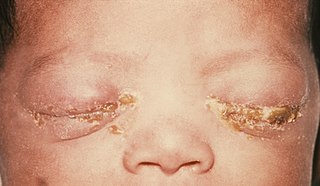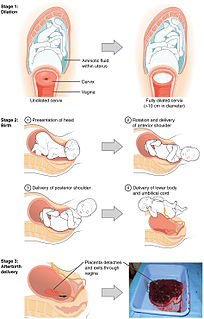
Meconium is the earliest stool of a mammalian infant. Unlike later feces, meconium is composed of materials ingested during the time the infant spends in the uterus: intestinal epithelial cells, lanugo, mucus, amniotic fluid, bile, and water. Meconium, unlike later feces, is viscous and sticky like tar, its color usually being a very dark olive green; it is almost odorless. When diluted in amniotic fluid, it may appear in various shades of green, brown, or yellow. It should be completely passed by the end of the first few days after birth, with the stools progressing toward yellow.

Caesarean section, also known as C-section, or caesarean delivery, is the use of surgery to deliver babies. A caesarean section is often necessary when a vaginal delivery would put the baby or mother at risk. This may include obstructed labor, twin pregnancy, high blood pressure in the mother, breech birth, or problems with the placenta or umbilical cord. A caesarean delivery may be performed based upon the shape of the mother's pelvis or history of a previous C-section. A trial of vaginal birth after C-section may be possible. The World Health Organization recommends that caesarean section be performed only when medically necessary. Some C-sections are performed without a medical reason, upon request by someone, usually the mother.
An infant is the more formal or specialised synonym for "baby", the very young offspring of a human. The term may also be used to refer to juveniles of other organisms.

Childbirth, also known as labour and delivery, is the ending of a pregnancy by one or more babies leaving a woman's uterus by vaginal passage or Caesarean section. In 2015, there were about 135 million births globally. About 15 million were born before 37 weeks of gestation, while between 3 and 12% were born after 42 weeks. In the developed world most deliveries occur in hospitals, while in the developing world most births take place at home with the support of a traditional birth attendant.

A postpartum period begins immediately after the birth of a child as the mother's body, including hormone levels and uterus size, returns to a non-pregnant state. The terms puerperium or puerperal period, or immediate postpartum period are commonly used to refer to the first 6 weeks following childbirth. The World Health Organization (WHO) describes the postnatal period as the most critical and yet the most neglected phase in the lives of mothers and babies; most maternal and/or newborn deaths occur during the postnatal period. In scientific literature, the term is commonly abbreviated to Px, where x is a number; for example, "day P5" should be read as "the fifth day after birth". This is not to be confused with the medical nomenclature that uses G P to stand for number and outcomes of pregnancy.

Preterm birth, also known as premature birth, is the birth of a baby at fewer than 37 weeks' gestational age. These babies are known as preemies or premies. Symptoms of preterm labor include uterine contractions which occur more often than every ten minutes or the leaking of fluid from the vagina. Premature infants are at greater risk for cerebral palsy, delays in development, hearing problems and sight problems. These risks are greater the earlier a baby is born.
Natural childbirth is childbirth without routine medical interventions, particularly anesthesia. Natural childbirth arose in opposition to the techno-medical model of childbirth that has recently gained popularity in industrialized societies. Natural childbirth attempts to minimize medical intervention, particularly the use of anesthetic medications and surgical interventions such as episiotomies, forceps and ventouse deliveries and caesarean sections. Natural childbirth may occur during a physician or midwife attended hospital birth, a midwife attended homebirth, or an unassisted birth. The term "natural childbirth" was coined by obstetrician Grantly Dick-Read upon publication of his book Natural Childbirth in the 1930s, which was followed by the 1942 Childbirth Without Fear.

Umbilical cord prolapse is when, during labor, the umbilical cord comes out of the uterus with or before the presenting part of the baby. The concern with cord prolapse is that pressure on the cord from the baby will compromise blood flow to the baby.
At the end of pregnancy, the fetus must take the journey of childbirth to leave the reproductive mother. Upon its entry to the air-breathing world, the newborn must begin to adjust to life outside the uterus.

Small for gestational age (SGA) newborns are those who are smaller in size than normal for the gestational age, most commonly defined as a weight below the 10th percentile for the gestational age.

A neonatal intensive care unit (NICU), also known as an intensive care nursery (ICN), is an intensive care unit specializing in the care of ill or premature newborn infants. Neonatal refers to the first 28 days of life. Neonatal care, as known as specialized nurseries or intensive care, has been around since the 1960s.

Subgaleal hemorrhage or hematoma is bleeding in the potential space between the skull periosteum and the scalp galea aponeurosis.

Neonatal conjunctivitis, also known as ophthalmia neonatorum, is a form of conjunctivitis and a type of neonatal infection contracted by newborns during delivery. The baby's eyes are contaminated during passage through the birth canal from a mother infected with either Neisseria gonorrhoeae or Chlamydia trachomatis.
The Newborns’ and Mothers’ Health Protection Act of 1996 is a piece of legislation relating to the coverage of maternity by health insurance plans in the United States of America. It was signed into law on September 26, 1996 and requires plans that offer maternity coverage to pay for at least a 48-hour hospital stay following childbirth.
Caesarean delivery on maternal request (CDMR) is a caesarean section birth requested by the pregnant woman without a medical reason.

Neonatal nursing is a subspecialty of nursing care for newborn infants up to 28 days after birth. The term neonatal comes from neo, "new", and natal, "pertaining to birth or origin". Neonatal nursing requires a high degree of skill, dedication and emotional strength as the nurses care for newborn infants with a range of problems, varying between prematurity, birth defects, infection, cardiac malformations and surgical problems. Neonatal nurses are a vital part of the neonatal care team and are required to know basic newborn resuscitation, be able to control the newborn's temperature and know how to initiate cardiopulmonary and pulse oximetry monitoring. Most neonatal nurses care for infants from the time of birth until they are discharged from the hospital. Approximately 40,000 low-birth-weight infants are born annually in the United States.

A vaginal delivery is the birth of offspring in mammals through the vagina. It is the natural method of birth for all mammals except monotremes, which lay eggs into the external environment. The average length of a hospital stay for a normal vaginal delivery is 36–48 hours or with an episiotomy 48–60 hours, whereas a C-section is 72–108 hours. Different types of vaginal deliveries have different terms:

Neonatal withdrawal or neonatal abstinence syndrome (NAS) is a withdrawal syndrome of infants after birth caused by in utero exposure to drugs of dependence. There are two types of NAS: prenatal and postnatal. Prenatal NAS is caused by discontinuation of drugs taken by the pregnant mother, while postnatal NAS is caused by discontinuation of drugs directly to the infant.
The Maternal and Newborn Health in Ethiopia Partnership (MaNHEP), based at Emory University’s Nell Hodgson Woodruff School of Nursing, is a two-and-a-half year initiative to demonstrate a community-oriented model for improving maternal and newborn health (MNH) care in rural Ethiopia. The project works in six districts in Oromia and Amhara Regions to strengthen the delivery of MNH services during the birth-to-48 hour period when mothers and newborns are most vulnerable. Training activities focus on improving the skills of health workers to deliver these services. Other efforts seek to increase demand for MNH services by pregnant women and promote healthy self-care behaviors that can improve newborn survival. Finally, a continuous quality improvement approach will be applied to strengthen district-level health systems to identify best MNH service delivery practices at the community level that can be spread to other regions and districts in Ethiopia. With more women and newborns receiving MNH care, a reduction in maternal and newborn mortality rates is expected to occur over time.

Neonatal infections are infections of the neonate (newborn) acquired during prenatal development or in the first four weeks of life. Neonatal infections may be contracted by mother to child transmission, in the birth canal during childbirth, or contracted after birth. Some neonatal infections are apparent soon after delivery, while others may develop in the postnatal period. Some neonatal infections such as HIV, hepatitis B, and malaria do not become apparent until much later.













